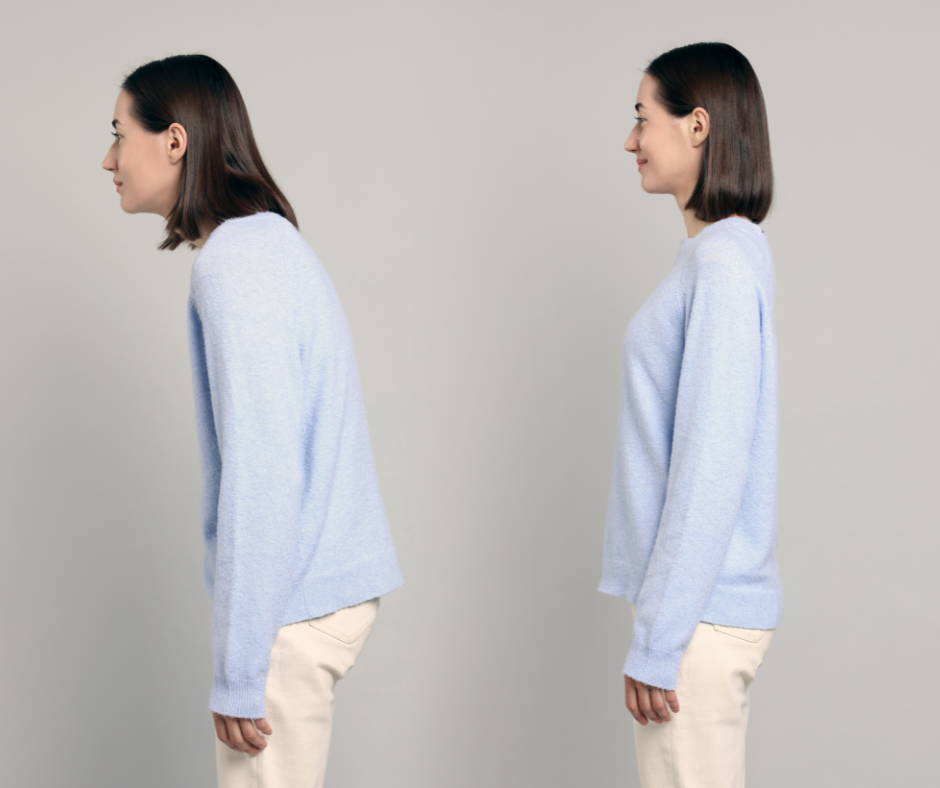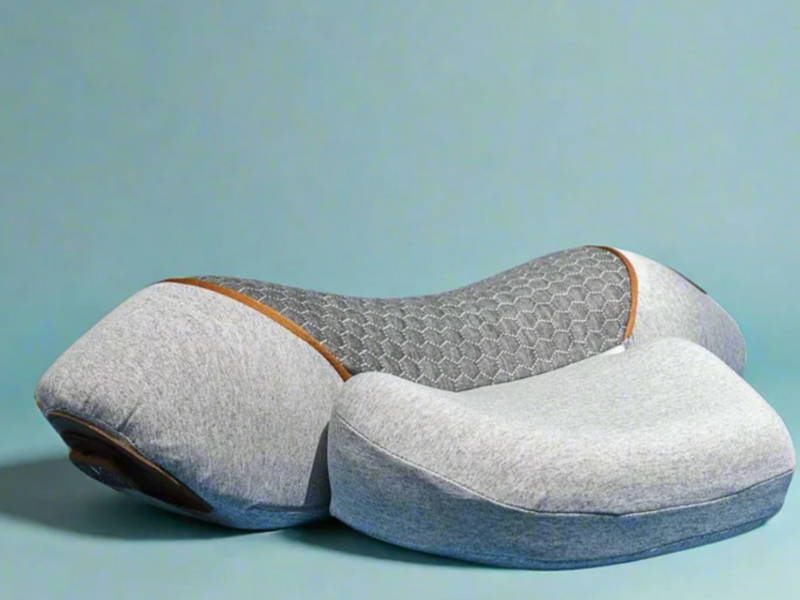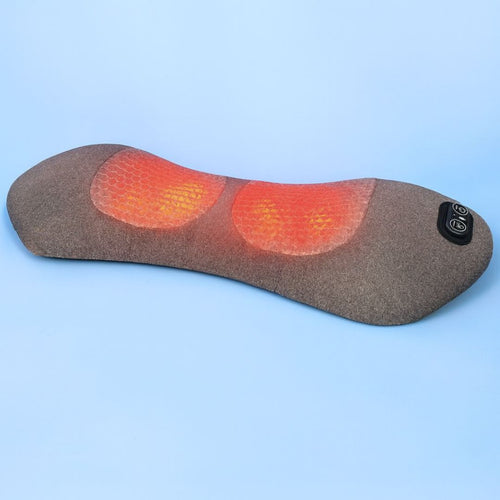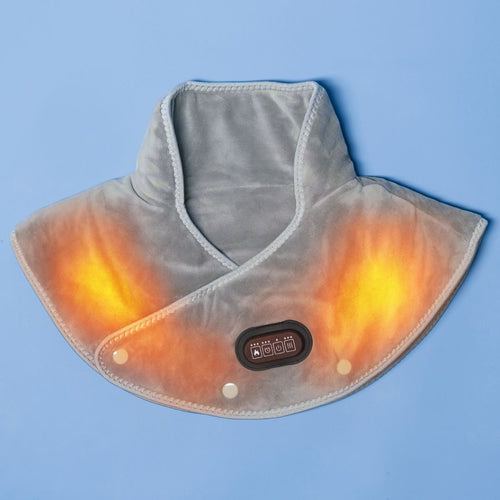How to Sleep to Fix Rounded Shoulders and Improve Posture
By Holly Grace Callis | Published on August 1st, 2025

You’re stretching, improving your posture, and adjusting your desk, but you still wake up with your shoulders rolled forward. Rounded shoulders aren’t just caused by sitting too much. How you sleep plays a major role in reinforcing this posture issue.
This guide explains how to fix rounded shoulders while you sleep, the best sleeping positions to support better alignment, and which tools help keep your body in a healthy position overnight.
What Causes Rounded Shoulders While You Sleep
Rounded shoulders often start during the day, but they get worse at night when your body rests in unsupported or poorly aligned positions.
Poor Sleep Positioning
Certain sleep positions push your shoulders forward without you realizing it. Curling your arms while side sleeping or sleeping on your stomach can pull your shoulders inward. This creates tension and reinforces the rounded shape that shows up during the day.
Even your mattress or pillow can work against you. If they don’t support your spine or shoulders properly, your body shifts into misaligned positions throughout the night, often without any pain until the next morning.
Muscle Imbalances and Lack of Support
Rounded shoulders also come from imbalances in your upper body. Tight chest muscles and weak upper back muscles are the most common pattern. When you lie down without proper support, those muscles stay stuck in the same faulty positions.
A flat pillow or an overly soft mattress may leave your spine unsupported for hours. Without support, your back muscles relax too much while the front of your body stays tight. That leads to poor alignment and makes your daytime efforts less effective.
Best Sleeping Positions to Fix Rounded Shoulders

Changing how you sleep can ease pressure on your shoulders and help your spine reset overnight. These sleep positions reduce forward rotation and give your upper body the support it needs.
1. Sleep on Your Back with Arm Support
Sleeping on your back naturally keeps your spine in a neutral position. To prevent your shoulders from rolling inward, place a small pillow or rolled towel under each arm. This slight lift helps keep your shoulders relaxed and aligned.
If your arms fall flat to your sides, your shoulders may still rotate forward. Arm support gives them a stable resting position and reduces muscle strain while you sleep.
2. Side Sleepers: Keep Shoulders Stacked
If you prefer sleeping on your side, shoulder support is still possible. Use a firm pillow between your knees to keep your spine straight. Then, focus on your upper body. Your top shoulder should stay stacked directly over the bottom one, not pulled forward across your chest.
A pillow that keeps your head level with your spine is essential. This keeps your neck and upper back aligned, preventing extra tension and reducing shoulder rotation overnight.
3. Avoid Sleeping on Your Stomach
Stomach sleeping is the least supportive position for shoulder and neck alignment. It forces your head to turn sharply to one side and often causes your shoulders to collapse inward. Over time, this posture can increase tightness in your chest and weaken your upper back.
If you’re used to sleeping on your stomach, try transitioning to your side or back using pillow placement for support. It may take time, but shifting away from stomach sleeping can significantly improve shoulder and spine alignment.
Tools to Help Retrain Shoulder Positioning While You Sleep

Sleep is a key time for your body to recover and reset. The right tools can help hold your body in better alignment through the night, reducing the pressure that causes rounded shoulders.
Posture-Supportive Pillows
A well-designed pillow supports the natural curve of your neck and upper spine. When your head and shoulders are properly aligned, your chest stays open, and your back muscles stay relaxed. This reduces the forward pull that worsens rounded shoulders.
Cervical pillows like the Thera Pillow or Mirella Conture Pillow cradle the neck and promote neutral alignment. They help reduce forward head posture, which often leads to shoulder collapse during sleep.
Back Braces or Sleep Straps (If Recommended by a Specialist)
Some people benefit from nighttime posture supports that gently hold the shoulders back. These tools can prevent your upper body from collapsing inward while you sleep. However, they should only be used with input from a healthcare provider.
These supports are best as short-term tools. Overuse without proper muscle training can create dependence. The goal is to remind your body of good posture, not force it.
Stretching and Muscle Activation Before Bed
What you do before bed can impact how your body rests overnight. Stretching your chest and activating your upper back muscles helps reset posture and reduce tightness before sleep.
Try a simple routine:
-Open your chest with doorway stretches
-Do gentle rows or band pulls to wake up your mid-back
-Add a short breathing exercise to help your body settle into better alignment
This routine doesn’t need to be long. A few minutes each night helps your body maintain a more neutral position during rest.
Bonus: Daytime Habits That Reinforce Better Posture
Sleep can support good posture, but your daytime habits shape it. Sit with your shoulders back and your ears aligned over your hips. Avoid hunching over phones or laptops, and take regular movement breaks.
Standing desks, posture reminders, and strength training all help reinforce what your body learns overnight. With the right habits, you prevent undoing the alignment gains you make while you sleep.
Sleep Smarter, Wake Straighter

Sleep should help your posture, not make it worse. Rounded shoulders often come from daily habits, but poor sleep positioning can slow your progress. By supporting your spine at night and using tools that promote alignment, you give your body the chance to reset.
By making some sustainable choices, like adjusting your sleep position, adding pre-bed stretches, or using a posture-supportive pillow, you can begin to see some real change. With consistency, you can wake up straighter, stronger, and pain-free.
Want to fix your posture overnight? Find the perfect wellness product at Callixe.
FAQs About Fixing Rounded Shoulders
How do you permanently fix rounded shoulders?
Lasting correction requires a mix of chest stretching, upper back strengthening, and daily posture awareness. Sleeping with better alignment and using supportive tools can help reinforce that progress overnight.
How long does it take to correct rounded shoulders?
Most people start seeing improvements within two to six weeks. Results depend on how often you stretch, strengthen, and support your posture while sitting, standing, and sleeping.
What muscles are weak with rounded shoulders?
The rhomboids, middle and lower trapezius, and rear deltoids are typically underactive. Strengthening these muscles helps pull your shoulders back into alignment.
Can a chiropractor fix rounded shoulders?
A chiropractor can help improve joint mobility and alignment, but long-term results depend on your daily habits. Stretching, strengthening, and consistent sleep support are key to lasting posture change.









